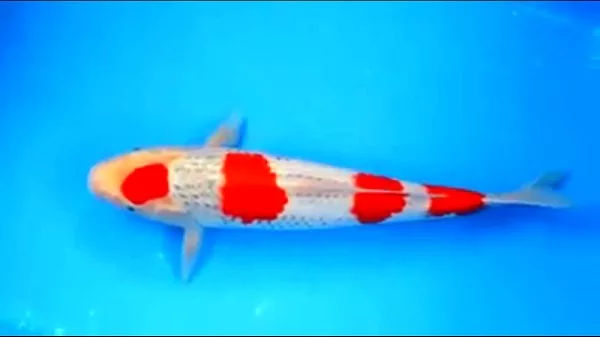
The Captivating Goshiki Koi: A Gem of Japanese Art
The Goshiki koi, a dazzling variety of ornamental fish, is a living testament to Japanese artistry and dedication to beauty. Born in 1918 from the union of Asagi and Kohaku koi, this vibrant fish lives up to its name, “Goshiki,” meaning “five colors.”
A Splash of Colors:
Goshiki koi are adorned with a captivating medley of hues. Their white bodies, reminiscent of freshly fallen snow, are overlaid with a mesmerizing net-like pattern of black, blue, and grey. This intricate design echoes the delicate brushstrokes of traditional Japanese ink paintings. Upon this canvas, a striking splash of bold red, known as the “Hi” plate, adds a touch of fiery brilliance. Unlike the subtler red of Kohaku koi, Goshiki’s Hi is a vibrant beacon, drawing the eye and adding a touch of drama to the overall spectacle.
Judging the Jewels:
Appreciating Goshiki koi goes beyond mere superficial beauty. Connoisseurs value koi that embody harmony and balance in their colors and patterns. An ideal Goshiki boasts a clear, Asagi-like blue in its netting, each scale adorned with a hint of “Ai” (indigo). The Hi plate, meanwhile, should be a true, unblemished red, its intensity adding to the koi’s overall magnificence.
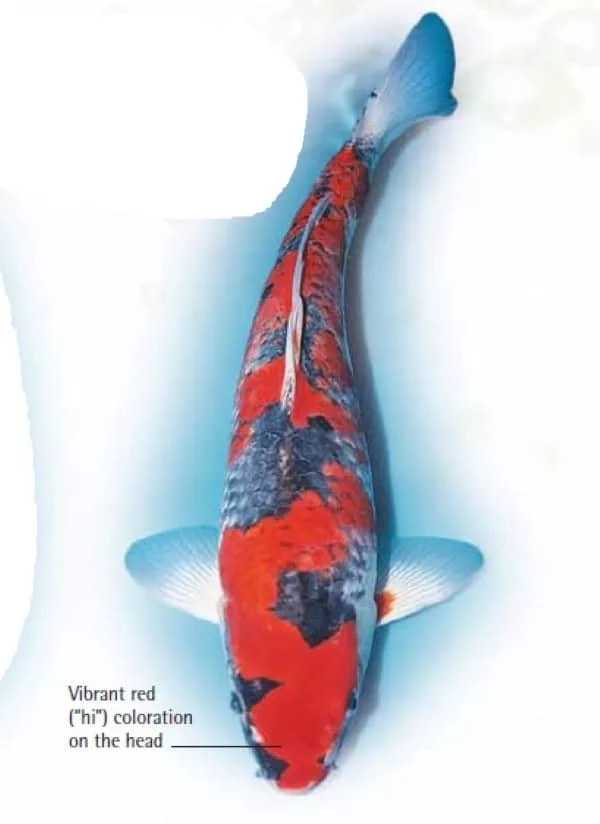
Caring for the Champions:
Maintaining the vibrancy of a Goshiki koi requires dedication and attentiveness. Mimicking the conditions of their birthplaces, mud ponds where their parents thrived, plays a crucial role. Recreating similar water quality can enhance the koi’s colors. Additionally, a well-balanced, nutritious diet rich in carotene is essential for maintaining the radiant Hi plate.
Evolution of Excellence:
The quest for the perfect Goshiki is an ongoing pursuit. Over the past two decades, the definition of a prize-winning specimen has subtly shifted. Today, judges favor koi with clean, net-like patterns devoid of large black splotches. A bright Hi plate that stands out against a pristine white body is the hallmark of a Goshiki koi that reigns supreme.
A Timeless Enchantment:
For centuries, Japan has captivated the world with its unique blend of culture and artistry. The Goshiki koi, with its dazzling colors and mesmerizing patterns, embodies this spirit perfectly. Owning and appreciating these living jewels is a privilege, offering a glimpse into the heart of Japanese beauty and a testament to the enduring power of human dedication to creating something truly exquisite.
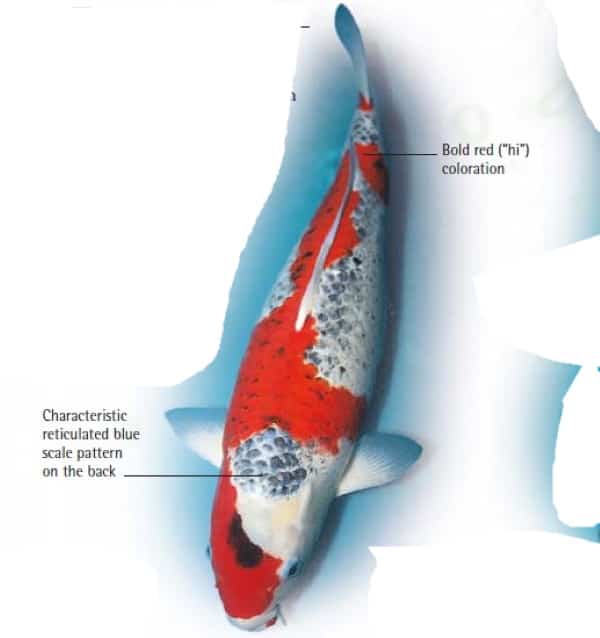
History and Origin of Goshiki Koi
A Sparkling Newcomer: The Goshiki Koi
While many Koi varieties boast centuries of history, the Goshiki is a relative newcomer, having debuted in the 1980s. Japanese breeders, eager to add a fresh splash to the pond, developed this unique fish by merging two existing types: the blue-scaled Asagi with its red-orange markings, and the white-scaled Sanke adorned with red and black.
This innovative crossbreeding yielded the Goshiki, a Koi so aptly named “Five-Colored” for its vibrant tapestry. Its scales shimmer with white, black, blue, red, and even hints of orange, creating a truly captivating spectacle.
Characteristics of Goshiki Koi
Five vibrant colors: The Goshiki Koi, meaning “Five Colors” in Japanese, lives up to its name with a stunning display of white, black, red, blue, and brown. These colors dance across its body in unique patterns, with each fish showcasing a personal blend of hues. Some may shimmer with more white or black, while others dazzle with bold splashes of red or blue.
Netted scales: Adding to its charm, the Goshiki Koi boasts a distinctive scale pattern. Imagine white scales delicately outlined in black, creating a mesmerizing net-like effect that covers its body.
Compact beauty: Unlike some Koi giants reaching three feet, the Goshiki Koi prefers a smaller life, typically resting comfortably at 12-18 inches. This makes it a perfect fit for smaller ponds and backyard water gardens, bringing a touch of vibrant life to any outdoor space.

Breeding Goshiki Koi
Breeding Goshiki Koi: A Rewarding, Yet Demanding Pursuit
Breeding Goshiki Koi is no simple feat. It demands both meticulous parent selection and dedicated offspring monitoring, making it a challenging yet deeply rewarding endeavor. Achieving high-quality Goshiki offspring hinges on choosing parent fish boasting exceptional traits: vibrant coloration, captivating patterns, and flawless scales.
Once the ideal brood pair is selected, the breeding journey commences. Female Koi release thousands of eggs in a single spawning event, promptly fertilized by the male. These precious eggs are then carefully transferred to a separate tank, where they hatch and begin their growth journey.
Throughout their development, the young fish are closely observed for the emergence of color and pattern. Those displaying promising characteristics are segregated, destined for future breeding. However, those failing to meet expectations may be offered for sale or released, paving the way for the next generation of exceptional Goshiki Koi.
Why Goshiki Koi are So Popular
Why Goshiki Koi are Swimming into Hearts:
Goshiki Koi are making a splash in popularity, and for good reason. Here are a few reasons these vibrant fish are captivating pond enthusiasts:
- Compact charm: Unlike some Koi that require expansive ponds, Goshiki thrive in smaller water features. This makes them a perfect fit for those with limited space or budget.
- Easy care: Forget finicky fish! Goshiki are relatively low-maintenance, making them an ideal choice for beginner pond owners.
- Spectacular colors: Goshiki Koi, as their name suggests (“five colors” in Japanese), boast a breathtaking blend of white, black, red, blue, and gray. Each fish is a unique masterpiece, a feast for the eyes.
- A touch of mystery: While many Koi types have been studied for centuries, Goshiki are a relatively recent creation, still holding secrets for researchers and enthusiasts to uncover. This air of discovery adds to their allure.
- Cultural significance: In Japan, Koi represent good luck, prosperity, and resilience. Goshiki, with their modern flair, embody the country’s spirit of innovation and creativity.
Overall, Goshiki Koi offer a combination of beauty, practicality, and cultural significance that makes them an irresistible choice for any pond or water garden. So, why not welcome a Goshiki or two into your own backyard oasis?
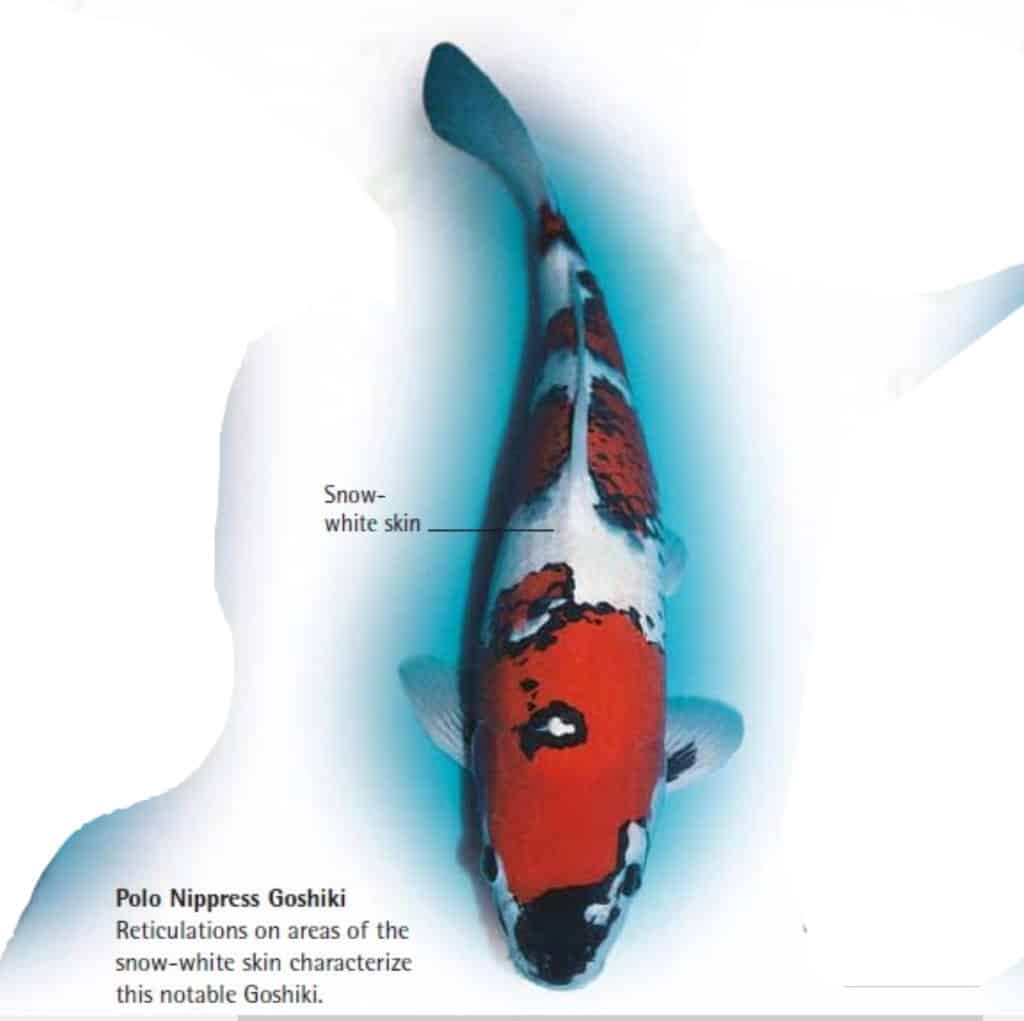
Caring for Goshiki Koi
Caring for your Goshiki Koi:
Goshiki Koi are typically easier to handle than some other Koi varieties, but still need proper care to flourish. Here are some essential tips:
- Spacious pond: While they can manage in smaller ponds, Goshiki Koi need room to swim and grow. Aim for at least 10 gallons of water per inch of fish, and remember a good filtration system keeps things clean and healthy.
- Balanced diet: Koi thrive on a balanced diet containing both protein and vegetables. Use commercial Koi food or create your own mix with fish meal, wheat germ, and veggies like peas and spinach.
- Water quality check: Regularly test your pond water for pH, ammonia, and nitrite levels, making adjustments as needed. Don’t forget regular water changes for a clean and healthy environment.
- Alert for illness: Keep an eye on your Goshiki Koi for signs of illness, including loss of appetite, lack of energy, or unusual swimming behavior. If you notice anything concerning, consult a vet or fish expert for diagnosis and treatment.
By following these simple tips, you can ensure your Goshiki Koi live healthy and happy lives, adding vibrant beauty to your pond for years to come.
Conclusion
What Makes the Goshiki Koi So Special?
- Striking Appearance: Goshiki Kois boast a stunning combination of colors and patterns. Their base is typically a crisp white, overlaid with a mesmerizing fishnet-like pattern of black, blue, and gray. This mesmerizing net gives way to bold splashes of vibrant red or orange, known as “Hi,” creating a truly mesmerizing contrast.
- Compact Size: Unlike some Koi varieties that can grow quite large, Goshiki Kois tend to stay on the smaller side, making them ideal for ponds of various sizes. This also makes them easier to manage and care for, especially for beginner hobbyists.
- Relatively Easy Care: Compared to some more delicate Koi breeds, Goshiki Kois are generally hardy and adaptable. They thrive in a variety of pond conditions and are not overly demanding in terms of maintenance. However, providing proper water quality, filtration, and a balanced diet is still essential for their well-being.
- Cultural Significance: Beyond their undeniable beauty, Goshiki Kois hold deep cultural significance in Japan. They are often associated with good luck, prosperity, and longevity, making them cherished symbols in ponds and water features.
Whether you’re a seasoned fish collector or just starting your aquatic journey, the Goshiki Koi is a fantastic fish to consider. Its captivating looks, manageable size, and relative ease of care make it a rewarding addition to any pond or water garden. And with its rich cultural symbolism, owning a Goshiki Koi can be more than just adding a beautiful fish to your space; it can be a symbol of good fortune and joy.
Goshiki Koi: A Colorful Journey in Ornamental Fishkeeping
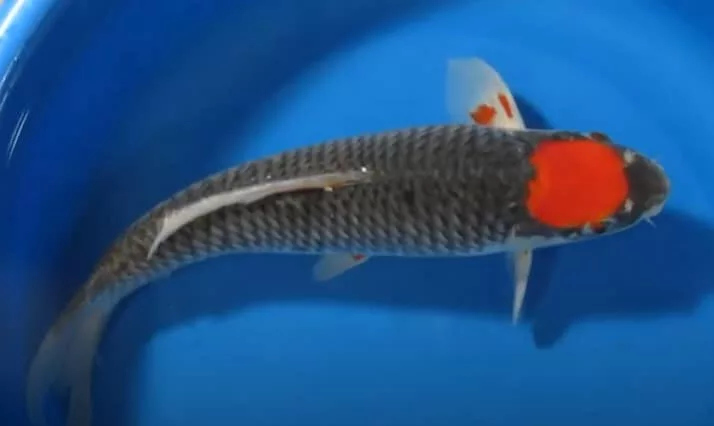
Introduction ????
In the world of ornamental fishkeeping, one breed that stands out with its vibrant colors and unique patterns is the Goshiki Koi. These captivating fish have gained immense popularity among enthusiasts for their striking appearance and fascinating history.
Origin and History ????
Goshiki Koi originated in Japan, where breeders carefully developed this distinct variety over the years. The breed’s history is intertwined with the evolution of Koi fish in general, showcasing the dedication and expertise of Japanese fish breeders.
Physical Characteristics ????
Goshiki Koi are easily recognizable by their distinctive color patterns, which include a mix of red, black, and white. The markings on their scales create a mesmerizing effect, making them a favorite among Koi enthusiasts. Additionally, their body shapes can vary, adding to the allure of this unique breed.
Goshiki Koi Varieties ????
There are several varieties of Goshiki Koi, each with its own set of characteristics. Some showcase a dominant red hue, while others emphasize the interplay of black and white. Understanding these varieties allows enthusiasts to appreciate the diversity within the Goshiki breed.
Types of Goshiki Koi ????
Delving deeper into Goshiki Koi, enthusiasts can explore various subtypes, each with its distinct traits. The types include:
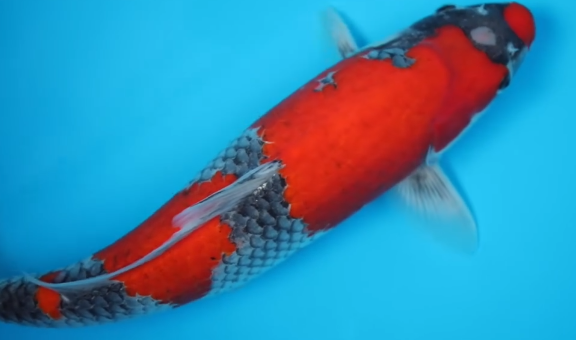
- Aka Goshiki (Red Goshiki) ????
- Notable for its rich red patterns on a white background.
- Considered a symbol of good luck and prosperity in Japanese culture.
- Ki Goshiki (Yellow Goshiki) ????
- Features vibrant yellow markings alongside the traditional black and white.
- Known for its cheerful and bright appearance.
- Ai Goshiki (Indigo Goshiki) ????
- Exhibits deep blue or indigo hues in addition to the classic Goshiki colors.
- Highly prized for its unique and sophisticated look.
- Shiro Goshiki (White Goshiki) ☁️
- Characterized by predominantly white scales with subtle red and black accents.
- Offers a serene and elegant presence in aquatic environments.
How to Choose a Goshiki Koi ????
Selecting the right Goshiki Koi for your pond or aquarium involves careful consideration of several factors:
- Color Intensity ????: Look for vibrant and well-defined color patterns.
- Body Conformation ????: Choose specimens with a balanced body shape and good proportions.
- Active Behavior ????: Opt for energetic and responsive Goshiki Koi, indicating overall health.
- Clear Eyes and Scales ????️: Ensure the eyes are clear, and scales are free from abnormalities or lesions.
When choosing Goshiki Koi, pay attention to individual preferences and consider how the selected fish will complement your existing aquatic environment.
Habitat and Tank Requirements ????️
Creating the ideal environment for Goshiki Koi is crucial for their well-being. These fish thrive in well-maintained ponds or aquariums with specific water quality parameters. Providing adequate space and maintaining optimal temperature levels contribute to the overall health of Goshiki Koi.
Feeding and Nutrition ????
Ensuring a balanced and nutritious diet is essential for Goshiki Koi. Their dietary preferences include high-quality Koi pellets and occasional treats. Establishing a regular feeding schedule not only enhances their colors but also promotes overall vitality.
Breeding Goshiki Koi ????
Breeding Goshiki Koi requires careful planning and attention to detail. Understanding the challenges associated with breeding helps enthusiasts navigate the process successfully. Tips on selecting breeding pairs and creating the right conditions contribute to a successful breeding endeavor.
Health and Disease Management ????️
Like any other ornamental fish, Goshiki Koi may face health issues. Being aware of common ailments and implementing preventive measures is crucial for maintaining a thriving Goshiki Koi population. Prompt identification and treatment of illnesses contribute to their longevity.
Goshiki Koi in Art and Culture ????
The beauty of Goshiki Koi extends beyond aquariums and ponds. These fish have influenced Japanese art for centuries, with their colors and patterns often depicted in traditional paintings and ceramics. The cultural significance of Goshiki Koi adds depth to their allure.
Goshiki Koi in Modern Aquascaping ????
Contemporary aquascaping has embraced the inclusion of Goshiki Koi, creating stunning underwater landscapes. Designers and hobbyists alike experiment with various layouts and themes, showcasing the adaptability of Goshiki Koi in modern aquatic design.
Tips for Goshiki Koi Enthusiasts ????
For those considering Goshiki Koi as their next aquatic companions, it’s essential to research and understand the specific needs of this breed. Selecting healthy specimens, providing a suitable environment, and avoiding common mistakes contribute to a rewarding experience.
Goshiki Koi Shows and Competitions ????
Goshiki Koi competitions attract enthusiasts and breeders from around the world. Judges evaluate various criteria, including color intensity, pattern symmetry, and overall health. The competitive aspect adds excitement to the Goshiki Koi community.
Environmental Conservation and Goshiki Koi ♻️
As interest in Goshiki Koi grows, responsible practices become imperative. Enthusiasts and breeders alike should prioritize sustainable approaches to ensure the well-being of Goshiki Koi and contribute to the conservation of their natural habitats.
Goshiki Koi Community and Resources ????
Engaging with fellow Goshiki Koi enthusiasts provides a valuable support network. Online communities and forums offer platforms for sharing experiences and gaining insights. Additionally, recommended books and websites serve as valuable resources for expanding knowledge.
Conclusion ????
In conclusion, Goshiki Koi offer a colorful journey for both seasoned and novice ornamental fish enthusiasts. Their rich history, captivating appearance, and cultural significance make them a fascinating addition to the world of aquaculture. As you embark on your Goshiki Koi journey, explore the diverse varieties, immerse yourself in their cultural context, and contribute to the thriving Goshiki Koi community.
FAQs about Goshiki Koi
Are Goshiki Koi suitable for beginners in fishkeeping?
Goshiki Koi can be suitable for beginners with proper research and commitment to their specific care requirements.
What is the lifespan of Goshiki Koi?
With proper care, Goshiki Koi can live for an average of 20 to 25 years.
Can Goshiki Koi be kept in indoor aquariums?
While they thrive in outdoor ponds, Goshiki Koi can be kept in large indoor aquariums with adequate filtration and space.
How do I enhance the colors of my Goshiki Koi?
Providing a balanced diet with high-quality Koi pellets and maintaining optimal water conditions can enhance the colors of Goshiki Koi.
What makes Goshiki Koi unique compared to other Koi varieties?
Goshiki Koi stand out for their distinctive color patterns, including a harmonious blend of red, black, and white, setting them apart from other Koi breeds.
You may also like
- https://www.giobelkoicenter.com/kigoi-koi/
- https://www.giobelkoicenter.com/ogon-koi-fish/
- https://www.giobelkoicenter.com/most-expensive-koi-fish/
- https://www.giobelkoicenter.com/matsuba-koi/
- https://www.giobelkoicenter.com/koi-egg-bound/